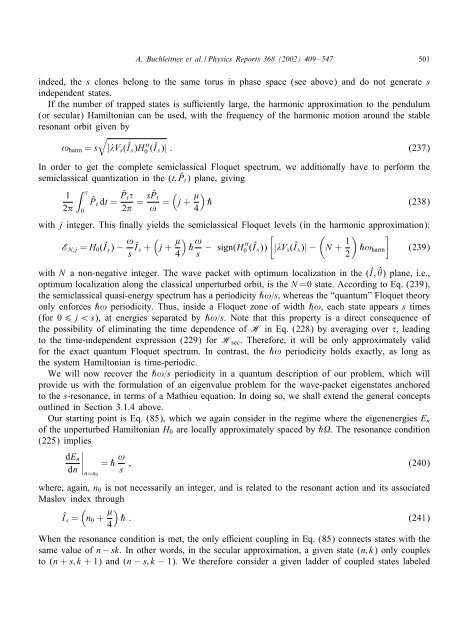Non-dispersive wave packets in periodically driven quantum systems
Non-dispersive wave packets in periodically driven quantum systems
Non-dispersive wave packets in periodically driven quantum systems
You also want an ePaper? Increase the reach of your titles
YUMPU automatically turns print PDFs into web optimized ePapers that Google loves.
A. Buchleitner et al. / Physics Reports 368 (2002) 409–547 501<br />
<strong>in</strong>deed, the s clones belong to the same torus <strong>in</strong> phase space (see above) and do not generate s<br />
<strong>in</strong>dependent states.<br />
If the number of trapped states is su ciently large, the harmonic approximation to the pendulum<br />
(or secular) Hamiltonian can be used, with the frequency of the harmonic motion around the stable<br />
resonant orbit given by<br />
<br />
!harm = s<br />
| Vs(Î s)H ′′<br />
0 (Î s)| : (237)<br />
In order to get the complete semiclassical Floquet spectrum, we additionally have to perform the<br />
semiclassical quantization <strong>in</strong> the (t; ˆPt) plane, giv<strong>in</strong>g<br />
<br />
1<br />
ˆPt dt =<br />
2 0<br />
ˆPt<br />
2 = s ˆPt<br />
! =<br />
<br />
j + ˝ (238)<br />
4<br />
with j <strong>in</strong>teger. This nally yields the semiclassical Floquet levels (<strong>in</strong> the harmonic approximation):<br />
EN;j = H0(Î s) − !<br />
s Î <br />
s + j + ˝<br />
4<br />
!<br />
<br />
′′<br />
− sign(H 0 (Î s)) | Vs(Î s)|− N +<br />
s 1<br />
<br />
˝!harm (239)<br />
2<br />
with N a non-negative <strong>in</strong>teger. The <strong>wave</strong> packet with optimum localization <strong>in</strong> the (Î; ˆ ) plane, i.e.,<br />
optimum localization along the classical unperturbed orbit, is the N =0 state. Accord<strong>in</strong>g to Eq. (239),<br />
the semiclassical quasi-energy spectrum has a periodicity ˝!=s; whereas the “<strong>quantum</strong>” Floquet theory<br />
only enforces ˝! periodicity. Thus, <strong>in</strong>side a Floquet zone of width ˝!, each state appears s times<br />
(for 0 6 j¡s), at energies separated by ˝!=s. Note that this property is a direct consequence of<br />
the possibility of elim<strong>in</strong>at<strong>in</strong>g the time dependence of H <strong>in</strong> Eq. (228) by averag<strong>in</strong>g over , lead<strong>in</strong>g<br />
to the time-<strong>in</strong>dependent expression (229) for Hsec. Therefore, it will be only approximately valid<br />
for the exact <strong>quantum</strong> Floquet spectrum. In contrast, the ˝! periodicity holds exactly, as long as<br />
the system Hamiltonian is time-periodic.<br />
We will now recover the ˝!=s periodicity <strong>in</strong> a <strong>quantum</strong> description of our problem, which will<br />
provide us with the formulation of an eigenvalue problem for the <strong>wave</strong>-packet eigenstates anchored<br />
to the s-resonance, <strong>in</strong> terms of a Mathieu equation. In do<strong>in</strong>g so, we shall extend the general concepts<br />
outl<strong>in</strong>ed <strong>in</strong> Section 3.1.4 above.<br />
Our start<strong>in</strong>g po<strong>in</strong>t is Eq. (85), which we aga<strong>in</strong> consider <strong>in</strong> the regime where the eigenenergies En<br />
of the unperturbed Hamiltonian H0 are locally approximately spaced by ˝ . The resonance condition<br />
(225) implies<br />
dEn<br />
dn<br />
<br />
<br />
<br />
n=n0<br />
= ˝ !<br />
s<br />
; (240)<br />
where, aga<strong>in</strong>, n0 is not necessarily an <strong>in</strong>teger, and is related to the resonant action and its associated<br />
Maslov <strong>in</strong>dex through<br />
<br />
Î s = n0 + ˝ : (241)<br />
4<br />
When the resonance condition is met, the only e cient coupl<strong>in</strong>g <strong>in</strong> Eq. (85) connects states with the<br />
same value of n − sk. In other words, <strong>in</strong> the secular approximation, a given state (n; k) only couples<br />
to (n + s; k + 1) and (n − s; k − 1). We therefore consider a given ladder of coupled states labeled











